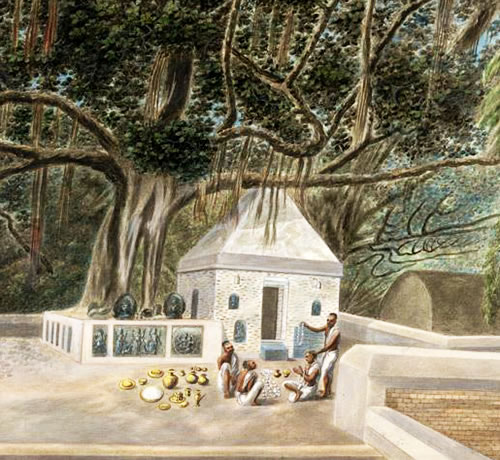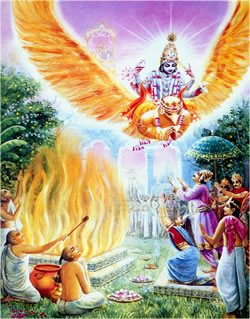How Long is a Year in
Vimsottari Mahadasa?
Page 4
1 2 3 4 5 6
Is the 360 day year advocated for Mahadasa usage some how Moon related and the 365 day year Sun related?
Those who advocate the 360 day year say it is Lunar while the 365 day year is Solar and say something like the following:
I once had a conversation with a jyotishi here in Australia who told me he uses the 360 day calendar as opposed to the 365 day calendar when calculating Vimsottari dasa. His argument was, why should we use a solar based calendar for calculating a lunar based dasa system?
This argument reveals several fallacies:
The first fallacy is that Vimsottari Mahadasa is "lunar based." Simply because the apparatus used for ascertaining what the mahadasa should be is based upon the Moon and Naksatras doesn't mean we should reject the standard year simply because it is based on the movement of the Sun. There are other systems of mahadasa which are not based on the Naksatras does that mean we should shift definitions for the length of the year to suit them? There is also the fact that Satyacarya has suggested that the Janma-naksatra be chosen from the stronger of the Moon or Lagna. If the Lagna were stronger then this would not be based on the Moon. In such cases would the length of the year be a different amount? Of course I want to quickly point out that Satycarya's suggestion of using the Lagna is not followed by many astrologers and the Moon's position is almost universally accepted as the standard for the janma-naksatra.
There are other systems of mahadasa which are not based on the Naksatras does that mean we should shift definitions for the length of the year to suit them?
The second fallacy, is the (wrong) assumption that since 365.25 is a solar year, we should reject it because mahadasa is a lunar based phenomena and rather accept a 360 day year. The unspoken assumption is that a 360 day year is somehow "Lunar." As we have pointed out before the Lunar year is not 360 days long but rather 360 tithis (lunar days) long, which is about 354.36 solar days long. Thus, since the 360 day year in not "Lunar" then it should not be favored and the 365.25 day year should not be rejected for being "Solar."
There is a third fallacy in this argument which leads us to the next question.
What is the relationship between the Solar and Lunar year?
The third fallacy is a bit more complex. The implicit assumption is that time measured by the lunar and solar calendar somehow yield different results. If we were to use a 360 d/y rather than a 365.25 d/y, for mahadasa calculations then there would be a difference. After some time they would become more and more divergent. After one year they would only be different by five days, but in six years it would be a gap of 31.5 days (counting leap years). After 35 years it would be about six months out of phase and after 70 years a whole year out of phase. Thus the older the person got the farther out of phase the mahadasas would be. Thus using the 360 d/y Jupiter mahadasa may start at age 35 but at age 35 y 6m using the solar year. This would introduce serious difficulties in timing events especially in regards to the Bhuktis. This difficulty would only increase with age. However, contrary to the implicit assumption of the advocates of the 360 d/y, there is no such discrepancy between the Vedic Lunar calendar and the Solar calendar. Actually the Vedic Lunar calendar is Solar as will be seen from the following quotation from Dikshit's BJS (emphasis mine):
'They purchased 'Soma' juice from the thirteenth month, and hence the thirteenth month is censurable.' Aitareya Brahmana
'Should the reins in the horse-sacrifice be twelve cubits in length or thirteen? The year consisting of (six) seasons is a kind of bullock whose hump is the thirteenth month. The horse-sacrifice is the best of all sacrifices. The year in the form of a bullock has got a hump (in the form of the thirteenth month).' Aitareya Brahmana
It is clear from the above quotations that the year was solar in the Vedic age. The natural means of measuring a year used to be one complete cycle of the seasons, just as the natural means of measuring a day was the period between two consecutive sunrises or that for measuring a month used to be the period between two full moons. The year as a unit of time could not come into being if seasons didn't exist. It is, therefore, obvious then that the year must have been solar.
. . . the seasons were naturally supposed to recur after 12 lunar months. Although, one complete cycle of seasons required 11 days more than 12 lunar months . . .[and the result of this difference of 11 days]. . . . . the lunar month which used to fall in the summer must shift to occur in the winter and later on in the rainy season and thus have gradually receded through all the seasons. Every month of such a calendar, like the Muharram of the Muslims, was bound to pass through all the seasons, thus completing a revolution in 33 years. [To avoid such a 33 year cycle] . . .to insert an intercalary month; and the fact that such an intercalary month used to be reckoned in the Vedic times goes to prove that the year was solar [even] in those days. This may appear trivial today, but it certainly was no ordinary matter that our people conceived the idea of inserting an intercalary month in those days of hoary antiquity. As a matter of fact it is extremely significant. The ancient Romans were at one time a very powerful nation, they used to regard the year as consisting of 10 months for quite a long time. . . (BJS vol. 1, pp. 20-21)
The Vedic Lunar calendar is actually a luni-solar calendar, that is, it is not independent from the Sun. A lunar month starts with the new Moon after the Sun enters into a sign and is named in accordance to the Solar sign or sometimes to the Naksatra in which the full Moon will take place in that Lunar month, the naming conventions differ in various geographical areas of India. In any case the lunar month is tied to the solar month. How the Solar year and Lunar year are linked shall now be explained.
The Vedic Lunar calendar is actually a luni-solar calendar, that is, it is not independent from the Sun.
The Lunar year consists of 12 lunar months each consisting of 30 tithis but this does not add up to 30 solar days since in the course of a lunar month a tithi will vary from about 19 hours to 26 hours with an average length of 23h 37m 28s. The lunar month would be 29.530589 days. Because the Lunar year is 360 tithis long, that is only 354.36 solar days long, after only three years it would be about one month out of phase with the solar year. However, to keep it in phase with the solar year, and thus with the seasons and religious observances, a leap month (adhika-masa) is introduced. The introduction of the adhika-masa is not artificial, but a natural occurrence (Metonic cycle) because about every third year there will be experienced the phenomena of two new Moons while the Sun transits through one Rasi. And, since the lunar month is defined as the length of time between successive new Moons and that there can only be one Lunar month corresponding to a solar month, the extra lunar month becomes a leap month. Thus the solar and lunar years would continue to stay in phase perpetually, their difference never being more than about 22 days. In the first year they would be out of phase by 11 days, the second year out of phase by 22 days, the third year the leap month brings them back in phase, the fourth year out of phase by 11 days, etc.
If the Vedic Lunar year were not linked to the solar year then within only a few years there would be very noticeable differences in a change of seasons in relation to the calendar. By an accumulation of about 11 days per year it would not take long before a festival associated with the summer such as Krsna Janmastami would be observed in the spring when Gaura Purnima should be observed. That would be absurd. However, there is a Lunar calendar which is independent of the Sun, the Islamic. In this calendar, based on a cycle of 30 years, 19 of which are 354 days long and 11 of which are leap years, having 355 days each. In 30 years each lunar month will have cycled through all the solar months. Thus the first month of the Muslim calendar Muharram will retrogress through the whole solar Gregorian calendar, and also through the Vedic luni-solar calendar. Returning to our argument; the Vedic lunar calendar is tied to the Sun thus the Vedic Lunar calendar is actually a Solar calendar. It will always be very close to the Solar calendar and never go out of phase as would a 360 day year which would only become more divergent with time.

